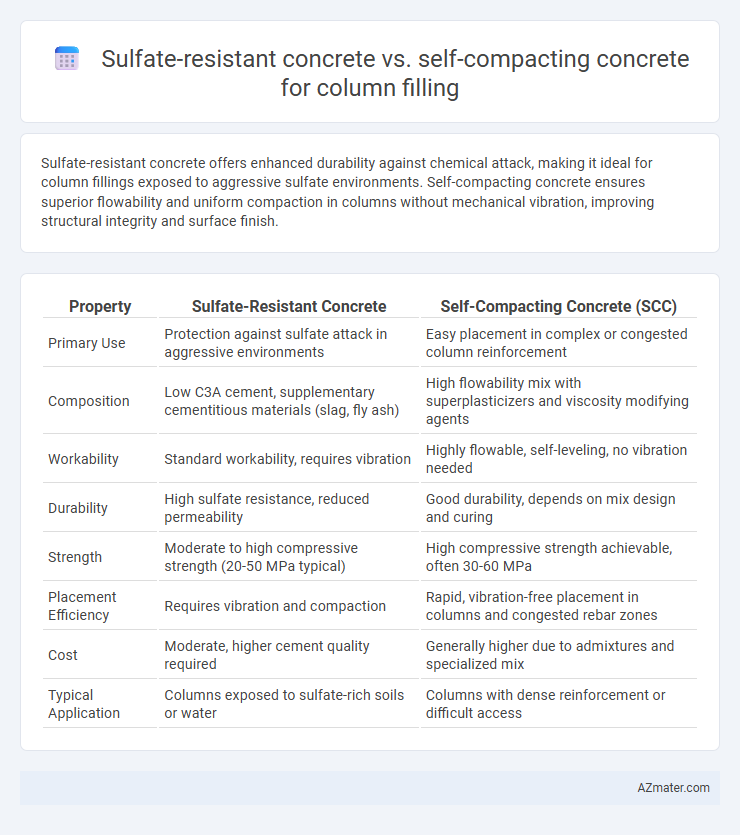Sulfate-resistant concrete offers enhanced durability against chemical attack, making it ideal for column fillings exposed to aggressive sulfate environments. Self-compacting concrete ensures superior flowability and uniform compaction in columns without mechanical vibration, improving structural integrity and surface finish.
Table of Comparison
| Property | Sulfate-Resistant Concrete | Self-Compacting Concrete (SCC) |
|---|---|---|
| Primary Use | Protection against sulfate attack in aggressive environments | Easy placement in complex or congested column reinforcement |
| Composition | Low C3A cement, supplementary cementitious materials (slag, fly ash) | High flowability mix with superplasticizers and viscosity modifying agents |
| Workability | Standard workability, requires vibration | Highly flowable, self-leveling, no vibration needed |
| Durability | High sulfate resistance, reduced permeability | Good durability, depends on mix design and curing |
| Strength | Moderate to high compressive strength (20-50 MPa typical) | High compressive strength achievable, often 30-60 MPa |
| Placement Efficiency | Requires vibration and compaction | Rapid, vibration-free placement in columns and congested rebar zones |
| Cost | Moderate, higher cement quality required | Generally higher due to admixtures and specialized mix |
| Typical Application | Columns exposed to sulfate-rich soils or water | Columns with dense reinforcement or difficult access |
Introduction to Sulfate-Resistant and Self-Compacting Concrete
Sulfate-resistant concrete is designed with low tricalcium aluminate content to withstand aggressive sulfate environments, making it ideal for columns exposed to soil or groundwater sulfates. Self-compacting concrete flows easily under its own weight, filling column forms completely without vibration, ensuring homogeneity and reducing voids. Both types enhance column durability, but sulfate-resistant concrete prioritizes chemical durability while self-compacting concrete emphasizes ease of placement and structural integrity.
Key Material Properties: Sulfate-Resistance vs Self-Compaction
Sulfate-resistant concrete is formulated with low C3A cement and supplementary cementitious materials to enhance durability against sulfate attack, ensuring structural integrity in aggressive soil or groundwater environments. Self-compacting concrete features high flowability and segregation resistance due to optimized mix design with superplasticizers and viscosity modifiers, enabling effortless placement and filling of complex column forms without mechanical vibration. Selecting between sulfate-resistant concrete and self-compacting concrete depends on prioritizing chemical durability in sulfate-rich conditions versus ease of placement and high-quality surface finish in column filling applications.
Chemical Composition and Durability
Sulfate-resistant concrete contains a low tricalcium aluminate (C3A) content, typically below 5%, minimizing its reaction with sulfate ions and enhancing durability in aggressive sulfate-rich environments. Self-compacting concrete features a highly flowable mixture with optimized particle packing and chemical admixtures like superplasticizers, ensuring uniform filling of columns without mechanical vibration. While sulfate-resistant concrete prioritizes chemical stability against sulfate attack for long-term durability, self-compacting concrete emphasizes rheological properties for ease of placement and consolidation, making the selection dependent on exposure conditions and structural requirements.
Workability and Placement Efficiency
Sulfate-resistant concrete is formulated to withstand aggressive sulfate environments while maintaining moderate workability, requiring careful vibration for proper consolidation during column filling. Self-compacting concrete (SCC) offers superior workability with high flowability and no segregation, enabling efficient, vibration-free placement in complex column forms and dense reinforcement. SCC significantly reduces labor and placement time, enhancing overall construction efficiency compared to sulfate-resistant concrete with conventional consistency.
Strength Performance in Column Applications
Sulfate-resistant concrete exhibits superior durability and compressive strength in aggressive sulfate environments, making it ideal for column applications exposed to sulfate-rich soils or groundwater. Self-compacting concrete offers excellent workability and uniformity, ensuring complete filling and reducing voids, which enhances the overall structural integrity of columns. While sulfate-resistant concrete focuses on chemical resilience, self-compacting concrete optimizes strength performance through improved density and homogeneity in column fillings.
Resistance to Environmental Aggressors
Sulfate-resistant concrete offers exceptional defense against sulfate attack, making it ideal for columns exposed to groundwater or aggressive soils containing high sulfate concentrations. Self-compacting concrete ensures uniform filling and compaction around reinforcement but requires sulfate-resistant cement or admixtures for enhanced durability in harsh environments. Selecting sulfate-resistant concrete optimizes column longevity in chemically aggressive conditions, while self-compacting concrete improves structural integrity through superior flow and consolidation.
Comparing Costs and Economic Considerations
Sulfate-resistant concrete typically incurs higher material costs due to specialized cement formulations designed to withstand aggressive sulfate environments, making it essential for durability in corrosive soils. Self-compacting concrete, while slightly more expensive than traditional mixes, reduces labor costs and accelerates construction timelines through enhanced flowability and ease of placement, particularly beneficial for complex column geometries. Evaluating project budgets requires balancing the upfront material premium of sulfate-resistant concrete against potential long-term repair savings and the labor efficiency gains provided by self-compacting concrete.
Suitable Construction Scenarios for Each Type
Sulfate-resistant concrete is ideal for columns exposed to aggressive sulfate-rich environments such as wastewater treatment plants or marine structures, providing enhanced durability and preventing chemical attack. Self-compacting concrete suits scenarios requiring rapid, dense filling around congested reinforcement without mechanical vibration, commonly used in high-rise buildings or complex formworks. Selecting the proper concrete depends on environmental exposure and the complexity of column reinforcement to balance durability and construction efficiency.
Maintenance and Long-Term Performance
Sulfate-resistant concrete offers enhanced durability against chemical attacks in aggressive environments, reducing maintenance frequency and extending the lifespan of columns exposed to sulfate-rich soils or groundwater. Self-compacting concrete ensures superior compaction without vibration, minimizing voids and improving early strength, which contributes to long-term structural integrity and reduced surface repairs. For column filling, combining sulfate-resistant properties with self-compacting characteristics can optimize maintenance demands and maximize long-term performance under severe exposure conditions.
Best Practices for Column Filling Selection
Sulfate-resistant concrete is ideal for column filling in environments exposed to high sulfate levels, providing enhanced durability and protection against chemical attacks. Self-compacting concrete offers superior flowability and compaction without vibration, ensuring void-free, uniform filling of complex column geometries. Best practices recommend assessing environmental exposure, structural requirements, and workability needs to select between sulfate-resistant concrete for durability and self-compacting concrete for ease of placement and finish quality.

Infographic: Sulfate-resistant concrete vs Self-compacting concrete for Column filling
 azmater.com
azmater.com